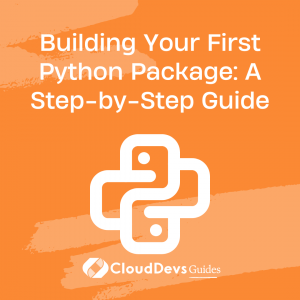Building Your First Python Package: A Step-by-Step Guide
Table of Contents
Python is a popular programming language with a large and supportive community. One of the great things about Python is its ability to easily share and distribute code through packages. In this blog post, we will guide you through the process of building your first Python package.
What is a Python Package?
A Python package is a collection of modules that can be imported and used in other Python programs. Packages are typically distributed through the Python Package Index (PyPI) and can be installed using tools like pip.
Why Build a Python Package?
Building a Python package has several benefits. It allows you to:
- Organize your code into reusable modules and functions
- Share your code with others and contribute to the Python community
- Use your code across multiple projects without duplicating code
- Automate tasks and reduce the chance of errors
Step 1: Plan Your Package
Before you start coding, it’s important to plan out your package. Consider the following questions:
- What problem does your package solve?
- What functionality should your package have?
- What should be the name of your package?
- What dependencies does your package require?
- What license should you use?
Step 2: Create a Directory Structure
Once you have a plan, it’s time to create the directory structure for your package. A typical structure includes:
- A top-level directory with the same name as your package
- A subdirectory for your package’s source code
- A subdirectory for your package’s tests
- A README.md file with information about your package
- A LICENSE file with the license information
Step 3: Write Your Code
Now it’s time to write the code for your package. It’s important to write clean, well-documented code that follows best practices. Here are some tips to keep in mind:
- Use meaningful variable names
- Write functions that do one thing and do it well
- Include comments to explain what your code does
- Follow PEP 8 guidelines for formatting and style
- Write unit tests to ensure your code works as expected
Step 4: Add a Setup.py File
The setup.py file is used to specify information about your package, such as its name, version, and dependencies. Here’s an example setup.py file:
from setuptools import setup, find_packages
setup(
name='mypackage',
version='0.1.0',
packages=find_packages(),
install_requires=[
'numpy',
'pandas',
],
tests_require=[
'pytest',
],
)
Step 5: Build and Distribute Your Package
Once you have written your code and added a setup.py file, you can build and distribute your package. Here’s how:
- Create a source distribution:
python setup.py sdist
This will create a .tar.gz file in the dist directory.
- Create a wheel distribution:
python setup.py bdist_wheel
This will create a .whl file in the dist directory.
- Upload your package to PyPI:
twine upload dist/*
This will upload your package to PyPI, where others can download and use it.
Conclusion
Building your first Python package can be a rewarding experience. It allows you to organize and share your code, automate tasks, and contribute to the Python community. In this blog post, we have guided you through the process of building a Python package, from planning and creating a directory structure to writing code and distributing your package. We hope that this guide has been helpful in getting you started on your journey to building great Python packages.
